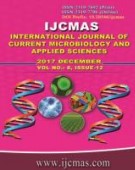


 National Academy of Agricultural Sciences (NAAS)
National Academy of Agricultural Sciences (NAAS)

|
PRINT ISSN : 2319-7692
Online ISSN : 2319-7706 Issues : 12 per year Publisher : Excellent Publishers Email : editorijcmas@gmail.com / submit@ijcmas.com Editor-in-chief: Dr.M.Prakash Index Copernicus ICV 2018: 95.39 NAAS RATING 2020: 5.38 |
Hemoglobin A1c (HbA1c), also known as glycated hemoglobin can be used as an indicator of a patient’s glycemic status for over a previous 3 months. Iron deficiency anemia (IDA) is one of the most prevalent forms of malnutrition. Reduced iron stores are shown to have a direct link with increased glycation of hemoglobin A1C (HbA1c), thereby leading to false-high values of HbA1c in the non-diabetic individuals. 98 diabetic patients and 86 non diabetic patients with anemia were included into the study. Hemoglobin levels, mean corpuscular hemoglobin (MCH), mean corpuscular hemoglobin concentration (MHCH), mean corpuscular volume (MCV), hematocrit, platelet count, total blood picture, differential leucocyte count was done for all samples. Samples from patients were tested for serum ferritin and haemoglobin at base line, 1 month and 2 months following iron treatment. Out of the total 98 diabetic patients, 42.9% were males and 57% were females. Among the non-diabetes also, the predominant gender were females 58.1% and males were 41.9%. The most common type of anemia among the diabetic patients was severe, seen in 66.3% cases, followed by moderate in 31.6. At baseline the hemoglobin in the anemic patients was 6.3 g/dL, while the serum ferritin was 7.3 mg/ml and HbA1c was 6.2% and 12.1 g/dL, 259 mg/ml and 5.1% respectively after 2 months of treatment with iron supplements. The HbA1c levels showed considerable reduction after the treatment. Thus, whenever HbA1c is calculated to detect the glycemic status of a patient, factors other than glucose also play a part in its calculated value, which should be kept in mind before a therapeutic treatment is given.
 |
 |
 |
 |
 |